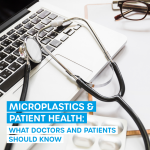
Microplastics and Patient Health
2. November 2025
Nanoplastics vs Microplastics and Analytical Challenges
6. November 2025MICROPLASTIC DETECTIVES:
Students Become Researchers for Clean Water
120 young people, 40 water samples, one mission: fighting microplastics!
When Students Become Environmental Detectives
Imagine you’re 15 years old, holding a fluorescence marker that reveals what’s invisible to the naked eye — tiny plastic particles polluting our waterways. That’s exactly what 120 students at the Integrated Comprehensive School Mannheim-Herzogenried will experience starting in 2026 — pioneering real progress in water and climate protection.
The Problem: Small but Mighty
Microplastics — plastic particles smaller than 5 millimeters — have become an invisible threat to our rivers and lakes. The alarming reality: only 8% of German rivers are in good ecological condition. While large rivers are regularly monitored, smaller water bodies often remain overlooked. This is where our new project comes in.
The Solution: Citizen Science Meets Innovation
With the MICROPLASTIC DETECTIVES project, we’re transforming classrooms into research labs and students into citizen scientists. The unique aspect: we use self-developed fluorescence markers that exclusively highlight synthetic particles — a technology already successfully applied in municipal and industrial monitoring for years.
How It Works
Phase 1: Preparation and Kick-off
All participants receive digital training, standardized analysis kits, and learn how real microplastic research works.
Phase 2: Local Data Collection
Over four months, students collect monthly water samples from ten selected sites along the Rhine, Neckar, and Bonadieshafen — CO₂-neutrally by foot or bicycle. Data are recorded in real time via the Wasser 3.0 app.
Phase 3: Scientific Analysis
In our research center, we analyze the samples using innovative fluorescence marker microscopy. Results are discussed and interpreted together with the students — a genuine scientific dialogue at eye level.
Phase 4: Action Plan and Public Outreach
The findings will be presented on World Water Day (March 22, 2026). Together with local stakeholders, students will develop concrete measures for microplastic-free waters. A public exhibition will make this invisible threat visible.
Why This Project Changes Everything
🔬 Scientifically Grounded
Not pseudo-science — real research using validated methods and laboratory analyses.
🌍 Climate-Relevant
Microplastics disrupt the natural climate regulation functions of aquatic ecosystems. Protecting water means protecting the climate.
🎓 Education of the Future
Cross-disciplinary integration into school curricula (biology, chemistry, science & technology) — learning that makes a difference.
🤝 Participatory and Inclusive
Everyone participates: students, teachers, environmental authorities, and local initiatives.
📊 Data-Driven
Forty new microplastic data points create an evidence-based foundation for municipal decision-making.
The Vision: From Mannheim to Europe
What begins in Mannheim aims to make waves across Europe. After the successful pilot phase, expansion to three German states is planned, followed by partnerships in five European regions.
Goal: to build a European network across ten countries that makes Citizen Science a standard practice in water protection.
The IGMH school already maintains partnerships in four countries and has the potential for eight more within the Erasmus+ network. The project is perfectly aligned with the EU Mission “Restoring our Oceans and Waters.”
An Investment in the Future
With support from the E.ON European Climate Fund, this innovative project becomes reality. A €10,000 grant enables the six-month pilot phase.
What makes it special: school infrastructure, digital devices, and educational materials are provided by project partners. Additional donations and sponsorships are sought to ensure long-term continuation.
Water Without Microplastics — Not a Utopia, but Achievable
MICROPLASTIC DETECTIVES shows that water protection doesn’t only work from the top down — it also thrives from the bottom up. When young people actively engage with scientific methods, real change happens.
It’s time for a new generation of researchers who make the invisible visible — for clean water and a livable future.






